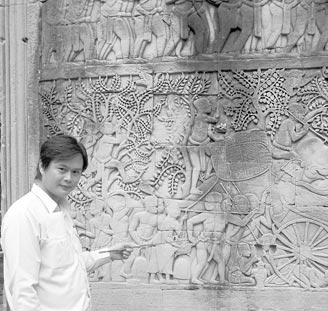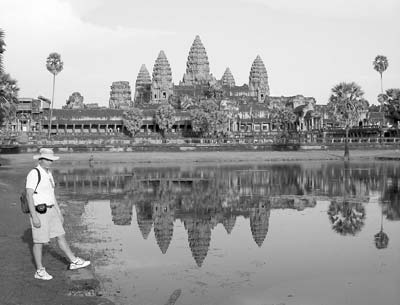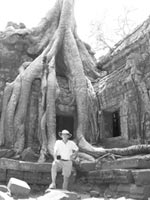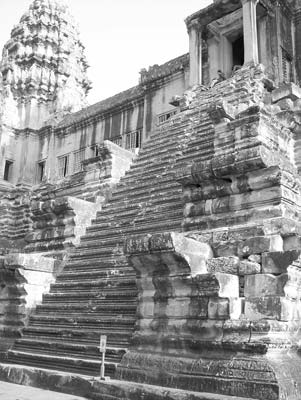The wats of Angkor and beyond
(Part 4 of 4 on Vietnam & Cambodia)
After my 1½ weeks in Vietnam, an evening arrival in Siem Reap, Cambodia, from Saigon provided me with the opportunity for an overnight respite before touring the remarkable remnants of the ancient Khmer civilization in and around the vicinity of Angkor Wat. I had arrived at one of the surviving great wonders of our world.
My accommodation for the next three nights was the luxurious, 238-room Sofitel Royal Angkor Golf & Spa Resort, arguably the finest hotel in the Siem Reap region. Its traditional, Cambodian-style, low-rise architecture was accented by alluring ponds and extensive garden landscaping. The enormous, ambling swimming pool was most welcome, especially during my daily midday break from the intensive heat between morning and afternoon touring.
Angkor Thom
My Cambodian guide, Lin, picked me up the next morning early to begin our exploration of massive Angkor Thom and thereby conclude our touring before the onset of the oppressive midday heat that one can expect during March.
In many ways, the huge Angkor Thom complex is even more spectacular than famous Angkor Wat. The city of Angkor Thom consisted of a square enclosing 360 acres, with a 100-meter-wide moat surrounding the outer wall. The last capital of the Khmer Empire, it was built in the late 12th century in the Bayan style, except for some earlier monuments.
Most visitors approach from the restored south gate with its soaring towers, the four faces complemented by elephants and pointing in the cardinal directions. The impressive approach to the gate, before the path crosses the moat, is lined with statues of gods, serpents and asuras (demons). Exploration of several hours to a half day is standard for most visitors to Angkor Thom.
Angkor Wat
Often, in life, the clash between reality and expectation disappoints. Such was not the case upon my beholding for the first time the colossal splendor that is Angkor Wat.
Angkor Wat is definitely the crown jewel in the architectural treasure trove of ancient Khmer civilization. However, I was already aware that it was but a single spectacular jewel in a crown that encompassed seven distinct districts and literally scores of rich sites deserving of exploration. While most visitors spend three to four days in the Angkor region, one could literally spend weeks on site.
My full afternoon was spent with Lin exploring the city which became the grandest of all the Khmer temples in the region. Angkor Wat, constructed between 1113 and 1150, with later additions, constitutes the world’s largest religious monument, the apogee of classical Khmer construction.
An architectural masterpiece, it achieves its intention of being a microcosm of the Hindu universe. Its “five peaks of Mount Meru” awe and inspire thousands of daily visitors, many of whom digitally capture the spires’ entrancing late-afternoon reflections in the moat fronting the western entrance.
Many hours could be spent examining just the nearly 600 meters of narrative bas-relief, featuring some 2,000 apsaras (celestial dancers). While Angkor Wat can be consumed in as little as half a day, many visitors return to spend additional time wandering and meditating, enraptured in personal wonderment.
Banteay Srei
My second morning was taken up with visits to three very different temple sites.
First up was the most distant, Banteay Srei, located a bit over 20 kilometers north of Angkor, near the base of the Kulen Mountains. This small temple is in unique miniature proportions and features intricate carvings in pink sandstone. It has an amazing concentration of mythological narratives on lintels and pediments.
Partially due to its pink hue, Banteay Srei displays a rare beauty and is routinely described as the “Jewel of Khmer Art.” Due to its compact size, it is a very wise idea to arrive early to avoid the crowds which often congest the grounds by midmorning.
Pre Rup
The imposing five brick towers in the center of the mid-10th-century Pre Rup stand tall in dominance over the surrounding plain. Pre Rup, like all state temples, was at the center of a city, but nothing remains of either those dwellings or boundaries.
Its construction materials — sandstone, brick and laterite — reveal a harmonious palate of colors. Those who are fit enough to manage the steep rock stair climb to and down from the upper terraces are rewarded with expansive views. This is an excellent site to visit at sunrise or sunset, as there are no nearby temples to impede the sun’s daily first and last dances on the horizon.
Ta Prohm
Imposing Ta Prohm (late 12th to 13th centuries) is a must-visit site featuring concentric galleries with gopuras (entrance pavilions) and corner towers amid a plethora of other buildings and enclosures.
A major part of Ta Prohm’s fascination to visitors is its partially collapsed state, with enormous strangler figs and silk-cotton trees entwined among the ruins, their tentacle-like roots ensnaring and then engulfing the ancient structures.
The massive roots for a time symbiotically function as a support system for the ruin structures until such time as the trees die or are felled by the elements, loosening and then collapsing the blocks and completing the cycle of growth and destruction.
Ta Prohm is likely the temple most photographed and written about aside from Angkor Wat.
Tonle Sap
In the afternoon, we drove through bustling Siem Reap en route to a boat cruise on the fascinating combined lake-and-river system Tonle Sap, whose importance to Cambodia cannot be overstated.
The Tonle Sap River connects the lake to the Mekong Delta and during the monsoon season reverses its flow, creating an annual flood cycle that increases the lake’s size from its usual 8,800-foot radius to over 52,000 feet. At the conclusion of the rainy season, the receding water leaves behind all-important mineral-rich sediment deposits that function as prime agricultural land for the remainder of the year.
At the somewhat primitive village at water’s edge, we boarded a sole-use craft and headed up a busy narrow channel to the open waters of the lake. We cruised among floating villages whose unique waterborne homes and other structures provided a photographic panacea.
A bit later we stopped at one of several mother-ship-type craft that function as restaurants, fish farms and souvenir shops.
Phnom Kulen Waterfall plus temple of the reclining Buddha
My final day in Cambodia, before my late-afternoon flight to Singapore, was at leisure. Feeling a desire to venture into the nearby Kulen Mountains, I arranged with my local host, Vido Tours, to travel to the Phnom Kulen Waterfall and the Preah Ang Thom Pagoda (late 15th century), whose large statue of the reclining Buddha is visited by thousands of Cambodians annually as well as a smattering of other visitors.
After the crowds of Angkor, the mountain village retreat with few other Westerners in evidence was welcome, indeed. I toured the temple grounds and hiked to the nearby waterfall for both gazing and a swim, enjoyed in the presence of only a few local youngsters.
The area is also known for the ancient lingas (a type of rock sculpture), which we observed carved into the rocks of the shallow river bottom. It is part of an expansive system of lingas and other rock sculptures farther downstream.
The adventurous one-way dirt road that traverses the mountain may help insulate this gift of nature from the ravages of mass tourism. Lin advised it is best to avoid on weekends, however, especially during the hot season, when locals at times descend en masse upon this mountain haven.
These hills have always been known to have great historic and religious significance, and they provided a fitting conclusion to my Cambodia adventure.
Cambodian massage
Considering myself to be something of a connoisseur of the experience of massage, I would be remiss in not recommending a traditional Cambodian massage, typically received while clothed in pajamas.
A combination of deep-tissue massage, reflexology and chiropractic, it was easily the most therapeutic massage experience I have encountered in my travels. The plethora of reputable local establishments charged $15 on average for a full hour’s treatment, a bargain by any standard. Go with the recommendation of your guide.
Singapore in a day
The timing of my international flights provided a long-overdue opportunity to reacquaint myself with the charms of Singapore. Despite all my recent wanderings in Asia, I had not returned to Singapore for nearly two decades.
The end of my whirlwind Indochina journey included taking advantage of the hop-on/hop-off Singapore Airlines tour bus to tour the full city circuit, with stops at most primary attractions. The cost was $2 for a full-day bus ticket for Singapore Airlines passengers and $8 for others.
My overnight was at the sleek, newly renovated Novotel (phone 65-6338-3333, www.accorhotels-asia.com/5993) at bustling Clarke Quay on the Singapore River, an area teeming with restaurants and convenient to most Singapore attractions.
Upper-floor rooms (US$120 and up, single or twin) provide expansive views of Clarke Quay and the city stretching all the way to the bay or, alternatively, the lush greenery of Fort Canning Park. Amenities includ a very large pool — unusual for a city hotel.
Overall, I found the property to be an excellent alternative to those on the often hectic Orchard Road hotel strip.
Planning for Vietnam and Cambodia
My 14-day journey through Vietnam and Cambodia in March 2007 was organized by SITA World Tours (16250 Ventura Blvd., Ste. 300, Encino, CA 91436; 800/421-5643, e-mail sitatours@sitatours.com or visit www.sitatours.com), which hosted the land portion of my journey.
My itinerary closely paralleled SITA’s “The Marvels of Indochina” tour, $2,495-$2,795 per person, double occupancy, including touring, meals and internal air, as listed in the itinerary. International air is currently $815 and up, depending on the U.S. departure gateway.
The combination of SITA and their impressive inbound operator, Vido Tours, resulted in a well-selected, well-paced itinerary with top-notch English-speaking guides. For information on the full range of their worldwide travel programs, contact SITA World Tours.
Keck's Beyond the Garden Wall
❝ Could these architects of wonderment
Have comprehended the strength of spirit
That their timeless monuments would impart
To a future world, humanity adrift? ❞
— Randy’s meditation on the wats of Angkor




